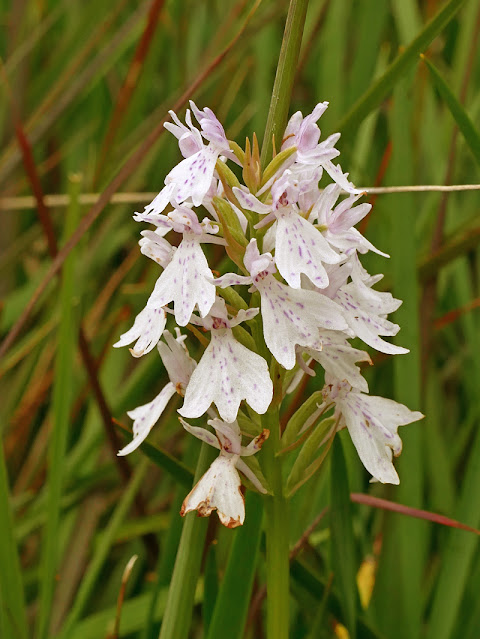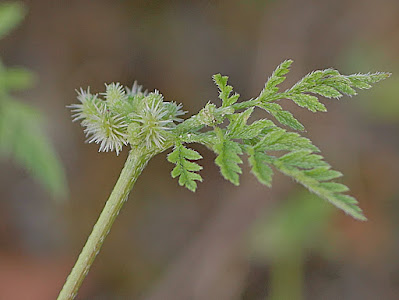Below follows a summary of interesting plants I came across whilst botanically recording in Cornwall in June, I hope you like the selection.
The non-descript, but sandy car park at Trevone Beach, continues to provide interesting plants. Last year, I found Toothed Medick in the worn areas where cars turn over the sand during the Summer months, this year, I found several patches of Rough Clover.
Trifolium scabrum
In the same car park were patches of Greek Sea-Spurrey. This is a tiny plant with flowers less than 8mm in diameter. With such tiny flowers, the only other plant it could be would be Sand Spurrey. The key to telling them apart is that in Sand Spurrey, the upper bracts are about the same length as the stem leaves (so both look like leaves of similar length), and pedicels are much longer than the capsules. With Greek Sea-Spurrey the upper bracts are much shorter than the stem leaves, or present as simple tiny stipules and most pedicels are shorter than the capsules. My personal observation too is that Sand Spurrey usually has a darker rose red petal colour, rather than pale pink to creamy white in Greek.
Sometimes, the habitat overlaps with Lesser Sea-Spurrey and then you have to look at whether the stipules on young shoots are fused for more than 1/3rd of their length or not. Also check seeds if present, winged seeds will be Greater or Lesser Sea-Spurrey only.
Spergularia bocconei
Navelwort (or Wall Pennywort) is so common here that it doesn't usually warrant a photograph, but because it can grow where other plants can't, it sometimes gives a botanical aspect to a great view, as below, near Cadgwith on The Lizard peninsular.
Umbilicus rupestris
We had pizza on the beachside at Polzeath recently, and afterwards I had a wander around (like one does). By the toilet block (there's always something interesting by them isn't there!) I found a diminuitive Fumitory growing on sandy soil. It was clearly Tall Ramping Fumitory, but it was small and not one of the variants I usually see. As such, I took a sample and sent photos to the referee. He agreed it was F. bastardii but didn't recognise the variant. It could well be var. gussonei but as the referee was unfamiliar with that variant, it remains unconfirmed. To work these plants out to species and sub species levels you really need a copy of the BSBI Fumitories Handbook.
Fumaria bastardii var gussonei (unconfirmed).
One weekend, I made a trip to East Cornwall to try and refind Bird's Nest Orchid, but failed to do so. I did find plenty of other plants though, like this Heath Spotted Orchid in peak condition.
Dactylorhiza maculosa subsp ericetorum
Southern Marsh were present too, but past their best. Other orchids were in the vicinity including both types of Butterfly Orchid, both are pollinated by moths with a long probiscis.
Platanthera chlorantha - Greater Butterfly Orchid
Note the diverging pollinia in Greater.
Platanthera bifolia - Lesser Butterfly Orchid
Note the parallel pollinia.
A very uncommon plant was also growing profusely in the same area. Below is the rare Cornish Bladderseed, a parsley like umbellifer with strange leaves compared to the more common lookalikes.
Physospermum cornubiense
Wild Raspberries were frequent in this woodland too.
Rubus ideaus
The stunning Bastard Balm put in an appearance on a woodland track edge.
Melittis melissophyllum
In places, the woodland floor was carpeted with Common Cow-wheat with hundreds in flower.
Melampyrum pratense subsp pratense
I saw a pair of small butterflies, about the same size as a Small Copper and I managed to get a photo. They turned out to be Heath Fritillaries, a rare butterfly in Cornwall.
Melitaea athalia
Welsh Poppy is considered native in Cornwall and this was a good example: in native deciduous woodland surrounded by native plants nowhere near habitation or likely fly tipping.
Papaver cambricum

I put my car in a for a service and had a wander around an industrial estate while I waited (like a botanist would do) and found 5 Southern Marsh Orchids hiding behind a pile of rubble from recent roadworks.
Dactylorhiza praetermissa
The coastal clifftops are becoming awash with flowers from now until July, below is one of the first to flower, Kidney Vetch, shown here with two colour forms growing together.
Anthyllis vulneraria
Western Sea-lavender coming into flower at Trevose Head, this one being a very small, drought resistant sub species.
Limonium brittanicum subsp brittanicum
Mid June and I took a visit to Greena Moor nature reserve in North East Cornwall, a relic of Culm grassland. Dotted around were lots of Flea Sedges, whose ripe seeds apparently fly off in different directions when touched.
Carex pulicaris
One of the reasons for my trip there was to try and find the hybrid between Meadow and Marsh Thistle. I found this hybrid easily at another nearby site last year, but after examining hundreds of thistles, I failed to find any. However, the Meadow Thistle is an attractive thistle and much loved by bees too.
Cirsium dissectum
Bitter Vetch was plentiful in parts of the reserve.
Lathyrus linifolius
A damp flush came out of a hillside and Bog Pimpernel had colonised it.
Lysimachia tenella
Water Purslane is a common plant in shallow pools, puddles and dried up wet areas, but it's quite hard to find one with all its petals intact as they fall off very quickly. So it was nice to find an intact one in a puddle frequented by cattle; the second photo shows the muddy pool they were growing in.
Lythrum portula
In the last week of June I went to Davidstow Woods, near Camelford. The woods themselves are quite barren, being a pine plantation woodland, with only a few ferns growing beneath them. But the woodland rides and open areas had more interest for me.
Alchemilla mollis - Garden Ladies Mantle
Confused Eyebright on short turf. To determine these properly to species level you really need to key specimens out using the BSBI Euphrasia Handbook (which I did). Previously recorded here too. One of the interesting traits of this species is that it often branches from the cotyledon node and the stem and branches are flexuous, not straight.
Euphrasia confusa
I don't see Heath Rush very often, but there were hundreds of tufts of it here, taking advantage of recently felled pine trees.
Juncus squarrosus
Creeping Forget-me-not is the species I usually see in the acidic wet areas of Cornwall, but here, the dominant species was Tufted Forget-me-not. It has smaller flowers and flattened hairs top and bottom of the stem, whereas Creeping has larger flowers (similar colour though), and patent hairs from the base to about half way up the stem. In the second photo you can see the sepal lobes are not equal in length x width. This separates it from Water Forget-me-not, which also has larger, usually deep blue flowers.
Myosotis laxa
Toad Rush on a woodland track
Juncus bufonius
Back to Wadebridge and on an evening walk I found the first Red Bartsia of the year (for me) in flower on a grassy verge.
Odontites vernus
Nearby were some Knotted Hedge Parsley, now in seed.
Torilis nodosa
Then I found a strange looking Balm-leaved Figwort, considered native in Cornwall: the leaves clearly showed this to be the species, but it was all green
with no red colouring in the flowers at all. Much like var Chlorantha Bee Orchids and
the like, this is a plant deficient in anthocyanins. It was a first for
me and only the 14th record for Cornwall since records began, so a nice
find.
Scrophularia scorodonia var. viridiflora
On the same walk I found a mystery Mullein. It had the look of Twiggy Mullein but its vigour and a combination of white and purple hairs on the stamens show this to be a hybrid plant. I keyed it out to be the hybrid between Twiggy and Great Mullein and I have sent photos to the BSBI referee for a determination. I still await his reply as I write. If it is, it will be a first for Cornwall. Both parents recorded nearby.
Verbascum x lemaitrei - unconfirmed
Update - the Verbascum referee determined this to be an atypical Twiggy Mullein after all. He stated that this species often has purple and white hairs on the stamens, yet the books never mention this combination. He is considering writing an article for BSBI News to put this right.
Verbascum virgatum - confirmed
Another plant that I found, but this time on a coastal clifftop in short turf had me confused. On first glance it looked like Slender Birdsfoot Trefoil, which is rare and would have been a great find. However, after speaking to the BSBI referee and my VCR, it clearly wasn't this species. It seems to be Common Birdsfoot Trefoil, but an uncommon hairy variant with a pronounced keel. There were hundreds of "normal" Common Birdsfoot Trefoils nearby, all virtually hairless and looking quite different to the one below.
Lotus corniculatus var. hirsutus - unconfirmed
After finding the above plant, I thought it might be useful to compare the various Lotus species you might find in the UK. For all the relevant details separating these species from each other, you really need to get a Wildflower ID book until you get to know them. I started off with Harrap's Wildflowers then went on to Stace and Sell and Murrell; the latter two being quite expensive, but well worth the money and essential if botany is your thing. After all, you wouldn't expect to become a golf professional if you carried on using the clubs you started out with playing pitch and putt would you?
I write this with 4 days of June left, though I doubt I will add anything to June's finds, but if I do, I will include them in next month's blog instalment. I hope you enjoyed the plant selection; as usual, I had to leave out so many species.
It's a lovely time of year for wild plants, so go and see what you can find in your own area.
Take Care
Dave
@Botany2021



















































































